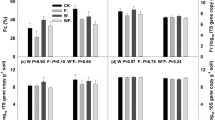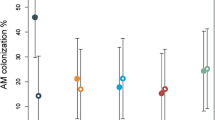Abstract
An experiment was conducted to study the effect of soil solarization on native arbuscular mycorrhizal (AM) fungi and soil microbial biomass. Solarization was done using transparent polyethylene (TPE) sheets of 0.05 and 0.10 mm thickness for 20, 40, and 60 days. Sunflower crop was taken after solarization. In plots solarized with 0.05 mm TPE sheets, soils solarized for 60 days had lesser number of infective propagules of AM fungi compared to those solarized for 40 or 20 days. However in soils solarized with TPE sheets of 0.10 mm thickness, no significant difference in spore numbers was found. Mycorrhizal colonization was significantly less in solarized soils, except in soils solarized with 0.10 mm TPE for 60 days. Soil microbial biomass increased as solarization period increased from 20 to 60 days in plots solarized with both 0.05 and 0.10 mm TPE. The yield of sunflower was significantly more in plots solarized for 60 days with TPE sheets of 0.05 or 0.10 mm thickness. There was a significant positive correlation between soil microbial biomass and seed yield. Though not significantly, soil microbial biomass and AM colonization were positively correlated, suggesting that mycorrhizal colonization might be stimulating soil microbial biomass. Therefore, even though microbial biomass correlated significantly with seed yield (r = +0.677*), the increase in seed yield could be attributed to an interaction effect of both AM colonization, and soil microbial biomass. This is the first report bringing out the various factors like solarization, AM colonization and soil microbial biomass on seed yield of sunflower.
Similar content being viewed by others
References
Afek U, Menge JA, Johnson ELV (1991) Interaction among mycorrhizae, soil solarization, metalaxyl, and plants in the field. Plant Dis 75:665–671
Bendavid-Val R, Rabinonowitch HD, Katan J, Kapulnik Y (1997) Viability of VAM fungi following soil solarization and fumigation. Plant Soil 195:185–193
Bendavid-Val R, Rabinonowitch HD, Katan J, Kapulnik Y (2004) Viability of VA-mycorrhizal fungi following soil solarization and fumigation. Plant Soil 195:185–193
Bonanomi G, Chiurazzi M, Caporaso S, Del Sorbo G, Moschetti G, Felice S (2008) Soil solarization with biodegradable materials and its impact on soil microbial communities. Soil Biol Biochem 40:1989–1998
Carter MR (1991) Ninhydrin-reactive N released by the fumigation extraction method as a measure of microbial biomass under field conditions. Soil Biol Biochem 23:139–143
Cook RJ, Baker KF (1983) The nature and practice of biological control of plant pathogens. American Phytopathological Society, St. Paul
Douds DD, Schenck NC (1990) Cryopreservation of spores of vesicular arbuscular mycorrhizal fungi. New Phytol 115:667–674
Gerdemann JW, Nicolson TH (1963) Spores of mycorrhizal Endogone species extracted from the soil by wet sieving and decanting. Trans Br Mycol Soc 46:235–244
Giovannetti M, Mosse B (1980) An evaluation of techniques to measure vesicular arbuscular infection in roots. New Phytol 84:489–500
Katan J, Gamliel A (2009) Soil solarization—30 years on: what lessons have been learned? In: Gisi U, Chet I, Gullino ML (eds) Recent developments in management of plant diseases, plant pathology in the 21st century, vol 1. Springer, Berlin, pp 265–283
Katan J, DeVay JE (1991) Soil solarization: Historical perspective principles and uses. In: Katon J, Devay JE (eds) Soil solarization. CRC Press, Boca Raton, pp 23–38
Little TM, Hills FJ (1978) Agricultural experimentation design and analysis. Willey and Sons, New York
Nair SK, Peethambaran CK, Geetha D, Nayar K, Wilson KI (1990) Effect of soil solarization on nodulation, infection by mycorrhizal fungi and yield of cowpea. Plant Soil 125:153–154
Nemec S (1987) Effect of storage temperature and moisture on Glomus species and their subsequent effect on citrus root stock seedling growth and mycorrhiza development. Trans Br Mycol Soc 89:205–212
Peachey RE, Pinkerton JN, Ivors KL, Miller ML, Moore LW (2001) Effect of soil solarization, cover crops, and metham on field emergence and survival of buried annual bluegrass (Poa annua) seeds. Weed Technol 15:81–88
Philips JM, Hayman DS (1970) Improved procedures for clearing and staining parasites and vesicular arbuscular mycorrhizal fungi for rapid assessment of infection. Trans Br Mycol Soc 55:158–161
Pullman GS, DeVay JE, Garber RH, Weinhold AR (1981) Soil solarization: effects on Verticillium Wilt of cotton and soilborne populations of Verticillium dahliae, Pythium spp., Rhizoctonia solani, and Thielaviopsis basicola. Phytopathology 71:954–959
Sharma SK, Rajesh K, Dohroo NP, Rajesh K (2004) Effect of soil solarization on Ralstonia solanacearum population and bacterial wilt of tomato in Himachal Pradesh. Indian Phytopathol 57:200–204
Sieverding E (1991) Vesicular Arbuscular Mycorrhiza Management in Tropical Agrosystems, Deutsche Gesellschaft fur Technische Zusammenarbeit (GTZ). Eschborn, Germany
Snedecor SW, Cochran WG (1968) Statistical methods. Oxford and IBH, New Delhi
Stapleton JJ, DeVay JE (1982) Effect of soil solarization on populations of selected soil-borne microorganisms and growth of deciduous fruit tree seedlings. Phytopathology 72:323–326
Stapleton JJ, DeVay JE (1986) Soil solarization: a non-chemical approach for management of plant pathogens and pests. Crop Prot 5:190–198
Sundararaj N, Nagaraju S, Venkataramu MN, Jagannath MK (1972) Design and analysis of field experiments. University Press, Bangalore
Author information
Authors and Affiliations
Corresponding author
Rights and permissions
About this article
Cite this article
Balakrishna, A.N., Lakshmipathy, R., Bagyaraj, D.J. et al. Effect of Soil Solarization on Native AM Fungi and Microbial Biomass. Agric Res 4, 196–201 (2015). https://doi.org/10.1007/s40003-015-0156-8
Received:
Accepted:
Published:
Issue Date:
DOI: https://doi.org/10.1007/s40003-015-0156-8




